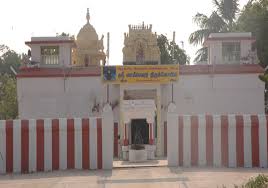Kuranganilmuttam Sri Valeeswarar Temple, Thiruvannamalai

Address
Kuranganilmuttam Sri Valeeswarar Temple, Mamandur Via Cheyyaru Taluk, Thiruvannamalai District, Tamil Nadu – 631 702. Phone: 07299904344, 09445642409.
Deity
Sri Valeeswarar / Sri Koyyamalarnathar Amman: Valaiyammai
Introduction
Kuranganilmuttam Valeeswarar Temple is a Hindu temple located at Kuranganilmuttam in Tiruvannamalai district, Tamil Nadu, India. The presiding deity is Shiva. He is called as Valeeswarar. His consort is known as Irayarvalai Ammai. Thiru Kuranganilmuttam is on the Kanchipuram to Vanthavasi route. After travelling about 10 kms from Kanchipuram, you can reach village Thusi and from here take a diversion road to Kuranganilmuttam. The temple is at a distance of about 2 kms from Thusi. This is one of the 276 Devara Paadal Petra Shiva Sthalams and 6th Shiva Sthalam in Thondai Nadu Theertham (Holy water) Kakkai Madu Theertham, Vali Theertham Sthala Vriksham (Sacred Tree) Elandhai
Puranic Significance
Summary of Puranic Significance
- The temple is located on the southern bank of the Palar River.
- It is believed to have been built by Pallava King Mahendra Verman in 637 CE.
- Legend: Vali (Monkey King), Indra (King of Celestial Gods), and Yama (Lord of Death) were cursed by sages for their wrongdoings and transformed into a monkey, a squirrel, and a crow, respectively.
- They prayed to Lord Shiva at Mount Kailash, who directed them to visit Kuranganil Muttam for redemption.
- At this place, they worshipped Lord Shiva, who absolved their sins and restored them to their original forms.
- Yama (in crow form) created a holy spring by scratching the land with his beak.
- This spring, named “Kakkaimadu Theertham” or “Vayasamadu Theertham”, surrounds the temple on three sides.
- Vali’s Devotion:
- Instead of plucking flowers with his hands, he shook a tree so that flowers fell directly on Lord Shiva.
- Hence, the deity is called “Koyyamalar Nathar” (Koyya = untouched, Malar = flower).
- Saint Thirugnanasambanthar referred to Lord Shiva as “Koyyamalar Chudi” in his hymns.
- The name “Kuranganil Muttam” is derived from the Tamil words:
- Kurangu (Monkey)
- Anil (Squirrel)
- Muttam (Crow)
- Since Vali worshipped Lord Shiva here, the deity is also called “Valeeswarar”.
Beliefs
Yama is considered to be the presiding lord of Planet Saturn. Those seeking relief from ill-effects of this planet (Sani dosham) can worship Lord Shiva here. It is believed that by worshiping Lord Shiva here devotees are relieved of sins and are blessed with wisdom and knowledge.
Special Features
- Idols and Shrines in the Temple Corridors:
- Lords Vinayakar, Murugan (with consorts), Kasi Viswanathar & Vishalakshi, Durgai, Chandikeswarar, Mahavishnu, Brahma, Dakshinamurthy, Sapthamathars, Suryan, Navagrahams, Bairavar, and Nalwars.
- Separate idols for Saint Thirugnanasambanthar and Saint Sekkizhar.
- Goddess Irayar Valai Ammai:
- Resides in a separate shrine facing west.
- Vali, Indra, and Yama worshipped her before Lord Shiva, seeking relief from their curse.
- The name “Irayar Valai Ammai” signifies “yielding to prayers” (Valai = yielding).
- Saint Thirugnanasambanthar praised her as “Irayar Valai” in his hymns.
- Special Worship and Beliefs:
- Women and expectant mothers offer bangles to the goddess, praying for safe childbirth and healthy children.
- Devotees seek her blessings for relief from Balarishta Dosham (illnesses affecting newborns due to planetary influences).
- Mythological and Astronomical Significance:
- Indian mythology depicts even birds and animals as Shiva devotees attaining salvation.
- Saint Sundaramurthy Nayanar mentioned this in his Pathigam (6th stanza at Thiruppunkur).
- During the Tamil month of Chithirai (April-May), sun rays fall directly on the Lingam in the sanctum sanctorum.
- Architectural Highlights:
- Stone engravings at the entrance wall depict animals worshipping Lord Shiva.
Festivals
Lakshadeepam (one lakh lamps) on Tirukarthikai in the Tamil month of Karthikai (November-December), Shivarathri in the Tamil month of Masi (February-March) and Annabishekam in the Tamil month of Aippasi (October-November) are the main festivals celebrated in this temple. Pradosha Pooja is regularly observed in a grand manner.
Century/Period/Age
1000-2000 years old
Managed By
Hindu Religious and Charitable Endowments (HRCE)
Nearest Bus Station
Kuranganilmuttam
Nearest Railway Station
Thiruvanamalai
Nearest Airport
Puducherry







